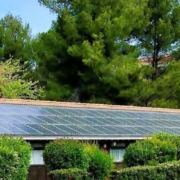Rooftop Solar Hits the Road

By Dave Trecker
Sunshine provides about 3% of all energy used in the United States. We harness it for things like electricity, heating, manufacturing and transportation.
And, although the sun isn’t getting any brighter, solar energy is gaining in stature. Utilities love it, especially those in areas with lots of sunshine. Its energy can be used on the spot or directed to the grid. Its tilted panels, considered eyesores by many, cover fields and dot hillsides, powering homes in Southwest Florida and other sunny locales.
Rooftop solar is a subset that avoids some of the unsightliness of solar fields and delivers power over short distances to where it’s needed most. On homes the panels can be embedded in roofing tiles. On flattop warehouses and other commercial buildings, the panels are easy to install and barely visible.
What makes this all possible is the remarkable improvements made over the years in converting light energy to usable power, in turn triggering an astonishing 5- to 10-fold drop in cost. Solar is now broadly affordable as an energy source. And that affordability is spawning new uses.
One of the new uses is solar-powered cars.
Pretty exciting stuff. Sunshine propelling cars down the highway.
The vehicles that make this happen take two forms. One is a standalone powered only by the sun and batteries with a range of up to 40 miles a day. The other, less radical, is a conventional EV with rooftop panels to extend its driving range.
The standalone, developed by Aptera Motors of Carlsbad, CA, has wrap-around solar panels on three sides of a tadpole-shaped three-wheeler. With a capacity of only two adults, it’s essentially an enclosed motorcycle.
But as long as the sun shines, it can get you where you want to go–providing the destination is not too far away.
Imagine the tadpole sitting in your driveway soaking up and storing the sun’s rays. You pop out and drive to the grocery store. Then, later in the day, you make a run to a nearby shopping center. And with energy stored in the battery, you cruise to dinner at a neighborhood restaurant at night.
The price for all this fun? A Wall Street Journal article says about $40,000 in 2026 when a limited number of these vehicles will be available. With other automakers jumping in and with any kind of production volume, the price could drop dramatically.
Big question: Can the wraparound panels withstand wear and tear like hail stones whacking them at a hundred miles an hour in a storm? Yes, say Aptera engineers. The chemically treated glass can withstand a hailstorm.
Even so, the little three-wheeler is unlikely to turn into a profitable business anytime soon. A jacked-up EV is a much betterbet.
According to the WSJ, Aptera is planning to sell its panels to Telo Trucks, a San Carlos, CA-based maker of a 500-horsepower EV. The solar boost from the panels installed flat on the vehicle’s roof and bed cover will cost about $4,000 and will add 15 to 30 miles to the truck’s driving range.
The potential is obvious, and the upside is huge. Telo is said to have already received some 3,000 orders for the solar-supplemented truck.
Other companies are jumping in. DartSolar wants to sell its panels to owners of existing EVs. The cost for roof-mounted solar panels would range upward to $4,000 and, best of all, the panels could be repaired or replaced.
Everyone says don’t get too excited. These are still early times. But as WSJ’s Christopher Mims points out, today’s EVs, honed to high efficiency, are ready right now to take on solar panels that will offset much of a driver’s daily mileage and cost.
Particularly in sunny climes, like Southwest Florida.
Dr. Trecker is a chemist and retired Pfizer executive living in Naples.




Leave a Reply
Want to join the discussion?Feel free to contribute!